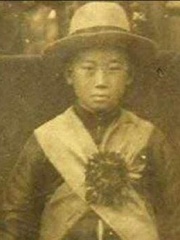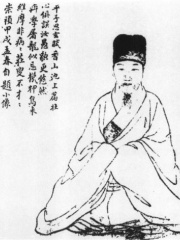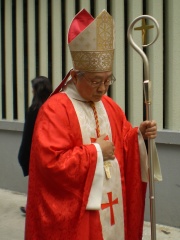RELIGIOUS FIGURE
Shaohao

 Shaohao
Shaohao
Shaohao (Chinese: 少皞; pinyin: Shàohào; lit. 'Lesser brightness'), also known as Jin Tian (金天), was a legendary Chinese sovereign, usually identified as a son of the Yellow Emperor. According to some traditions, such as that within the Book of Documents, Shaohao is one of the Five Emperors. His place in the mythical lineage of the Yellow Emperor has been subject to controversy. Read more on Wikipedia
His biography is available in 26 different languages on Wikipedia. Shaohao is the 1,418th most popular religious figure (down from 1,212th in 2024), the 487th most popular biography from China (up from 497th in 2019) and the 11th most popular Chinese Religious Figure.
Memorability Metrics
Page views of Shaohao by language
Among RELIGIOUS FIGURES
Among religious figures, Shaohao ranks 1,418 out of 3,187. Before him are John Carroll, Eulogius of Alexandria, Ebussuud Efendi, Aga Khan II, Andrew Yeom Soo-jung, and Marcial Maciel. After him are Simon Stock, Philippe Barbarin, Annie Chapman, Michael von Faulhaber, Charles of Austria, Bishop of Wroclaw, and Muslim ibn Aqil.
Most Popular Religious Figures in Wikipedia
Go to all RankingsJohn Carroll
1735 - 1815
HPI: 63.89
Rank: 1,412
Eulogius of Alexandria
501 - 608
HPI: 63.89
Rank: 1,413
Ebussuud Efendi
1490 - 1574
HPI: 63.89
Rank: 1,414
Aga Khan II
1830 - 1885
HPI: 63.88
Rank: 1,415
Andrew Yeom Soo-jung
1943 - Present
HPI: 63.88
Rank: 1,416
Marcial Maciel
1920 - 2008
HPI: 63.87
Rank: 1,417
Shaohao
HPI: 63.86
Rank: 1,418
Simon Stock
1164 - 1265
HPI: 63.85
Rank: 1,419
Philippe Barbarin
1950 - Present
HPI: 63.85
Rank: 1,420
Annie Chapman
1841 - 1888
HPI: 63.85
Rank: 1,421
Michael von Faulhaber
1869 - 1952
HPI: 63.82
Rank: 1,422
Charles of Austria, Bishop of Wroclaw
1590 - 1624
HPI: 63.81
Rank: 1,423
Muslim ibn Aqil
650 - 680
HPI: 63.81
Rank: 1,424
In China
Among people born in China, Shaohao ranks 487 out of 1,610. Before him are Li He (790), Hong Tianguifu (1849), Zhang Lu (101), Han Gan (706), He Zizhen (1910), and Wang Bi (226). After him are Ruan Ji (210), Tonyukuk (646), Dong Qichang (1555), Zhang Juzheng (1525), Edward Yang (1947), and Shangguan Wan'er (664).
Others born in China
Go to all RankingsLi He
WRITER
790 - 816
HPI: 63.96
Rank: 481
Hong Tianguifu
POLITICIAN
1849 - 1864
HPI: 63.95
Rank: 482
Zhang Lu
POLITICIAN
101 - 216
HPI: 63.90
Rank: 483
Han Gan
PAINTER
706 - 783
HPI: 63.87
Rank: 484
He Zizhen
POLITICIAN
1910 - 1984
HPI: 63.87
Rank: 485
Wang Bi
PHILOSOPHER
226 - 249
HPI: 63.86
Rank: 486
Shaohao
RELIGIOUS FIGURE
HPI: 63.86
Rank: 487
Ruan Ji
WRITER
210 - 263
HPI: 63.85
Rank: 488
Tonyukuk
POLITICIAN
646 - 724
HPI: 63.85
Rank: 489
Dong Qichang
PAINTER
1555 - 1636
HPI: 63.84
Rank: 490
Zhang Juzheng
POLITICIAN
1525 - 1582
HPI: 63.83
Rank: 491
Edward Yang
FILM DIRECTOR
1947 - 2007
HPI: 63.82
Rank: 492
Shangguan Wan'er
POLITICIAN
664 - 710
HPI: 63.81
Rank: 493
Among RELIGIOUS FIGURES In China
Among religious figures born in China, Shaohao ranks 11. Before him are Yijing (635), Joseph Zen (1932), 11th Dalai Lama (1838), Dazu Huike (487), Ignatius Kung Pin-Mei (1901), and Bao Xishun (1951). After him are Rabban Bar Sauma (1220), Jianzhen (688), Sengcan (529), Gan Ji (101), Mang of Xia (null), and Witness Lee (1905).
Yijing
635 - 713
HPI: 67.50
Rank: 5
Joseph Zen
1932 - Present
HPI: 66.29
Rank: 6
11th Dalai Lama
1838 - 1856
HPI: 65.48
Rank: 7
Dazu Huike
487 - 593
HPI: 65.13
Rank: 8
Ignatius Kung Pin-Mei
1901 - 2000
HPI: 64.38
Rank: 9
Bao Xishun
1951 - Present
HPI: 64.37
Rank: 10
Shaohao
HPI: 63.86
Rank: 11
Rabban Bar Sauma
1220 - 1294
HPI: 63.40
Rank: 12
Jianzhen
688 - 763
HPI: 62.47
Rank: 13
Sengcan
529 - 606
HPI: 62.37
Rank: 14
Gan Ji
101 - 200
HPI: 61.45
Rank: 15
Mang of Xia
HPI: 60.79
Rank: 16
Witness Lee
1905 - 1997
HPI: 59.48
Rank: 17




































